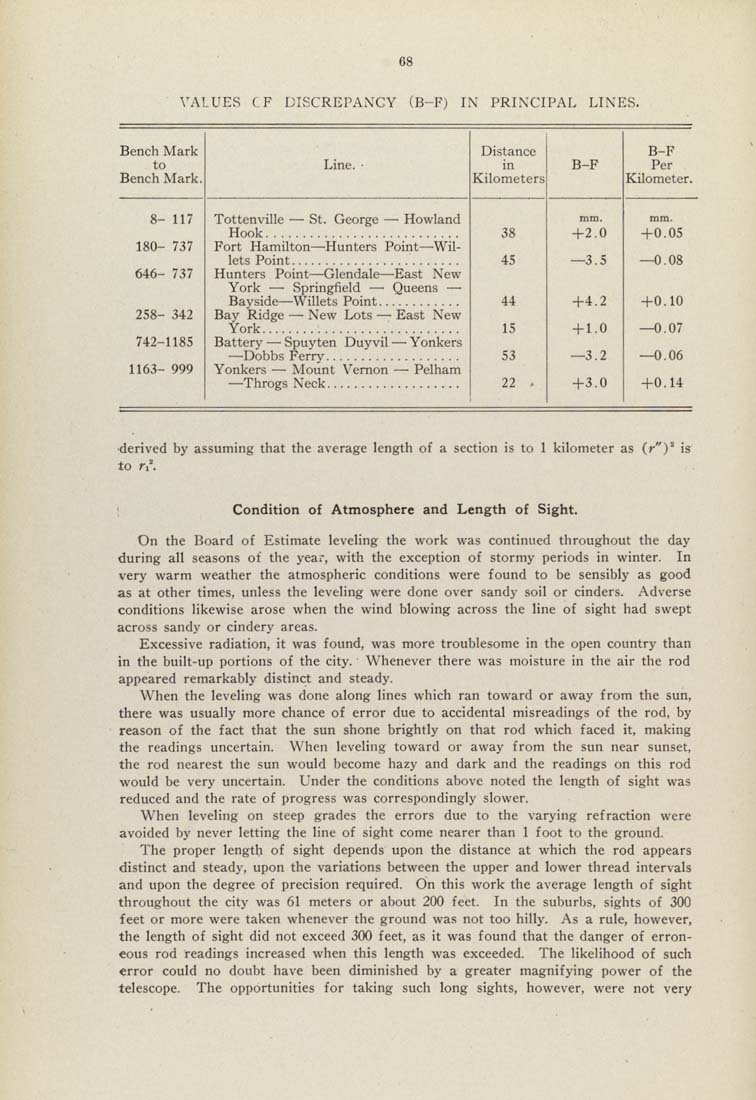VALUES CF DISCREPANCY (B-P) I.\ PRINCIPAL LINES.
Bench Mark
to
Bench Mark.
Line. ■
Distance
in
Kilometers
B-F
B-F
Per
Kilometer.
8- 117
180- 737
Tottenville — St. George — Howland
Hook...........................
Fort Hamilton—Hunters Point—Wil-
38
45
44
15
53
22 .
+2.0
—3.5
+4.2
+ 1.0
—3.2
+3.0
+0.05
646- 737
Hunters Point—Glendale—East New
York — Springfield — Queens —
258- 342
742-1185
Bay Ridge — New Lots — East New
York............................
Battery — Spuyten Duyvil — Yonkers
—0.07
—0.06
1163- 999
Yonkers — Mount Vernon — Pelham
—Throgs Neck...................
+0.14
■derived by assuming that the average length of a section is to 1 kilometer as (r"y is
to ri".
Condition of Atmosphere and Length of Sight.
On the Board of Estimate leveling the work was continued throughout the day
during all seasons of the year, with the exception of stormy periods in winter. In
very warm weather the atmospheric conditions were found to be sensibly as good
as at other times, unless the leveling were done over sandy soil or cinders. Adverse
conditions likewise arose when the wind blowing across the line of sight had swept
across sandy or cindery areas.
Excessive radiation, it was found, was more troublesome in the open country than
in the built-up portions of the city. ■ Whenever there was moisture in the air the rod
appeared remarkably distinct and steady.
When the leveling was done along lines which ran toward or away from the sun,
there was usually more chance of error due to accidental misreadings of the rod, by
reason of the fact that the sun shone brightly on that rod which faced it, making
the readings uncertain. When leveling toward or away from the sun near sunset,
the rod nearest the sun would become hazy and dark and the readings on this rod
would be very uncertain. Under the conditions above noted the length of sight was
reduced and the rate of progress was correspondingly slower.
When leveling on steep grades the errors due to the varying refraction were
avoided by never letting the line of sight come nearer than 1 foot to the ground.
The proper length of sight depends upon the distance at which the rod appears
distinct and steady, upon the variations between the upper and lower thread intervals
and upon the degree of precision required. On this work the average length of sight
throughout the city was 61 meters or about 200 feet. In the suburbs, sights of 300
feet or more were taken whenever the ground was not too hilly. As a rule, however,
the length of sight did not exceed 300 feet, as it was found that the danger of erron¬
eous rod readings increased when this length was exceeded. The likelihood of such
error could no doubt have been diminished by a greater magnifying power of the
telescope. The opportunities for taking such long sights, however, were not very
|








